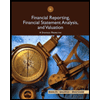
a.
Introduction: The return on assets is a financial ratio which states that how profitably a company has employed its assets. In other words, how the company has utilized its assets to generate income.
Requirement 1
The return on assets of S company for the current year and the prior year.
b.
Introduction: Multiple factors can be responsible for causing the financial ratios to change from one year to another. The reasons for such change are then further analyzed in order to take appropriate action.
Requirement 2
Whether S’s return on assets has shown a favorable or unfavorable change.
c.
Introduction: Comparison between similar companies in the same industry is crucial to the assessment of the company’s performance. A company’s financial ratios, when compared with the industry data, can reveal lots of valuable information which the financial statements can not reveal.
Requirement 3
The S company’s return on assets for the current year is better or worse than companies A and G’s return on assets.
Want to see the full answer?
Check out a sample textbook solution
Chapter 1 Solutions
FINANCIAL+MANAG.ACCT.(LOOSE)-W/CONNECT
- Don't use ai. A company has the following data: Cash: $50,000Accounts Receivable: $30,000Inventory: $60,000Current Liabilities: $70,000a) What is the company’s acid-test ratio?b) Is the company in a strong liquidity position based on this ratio?arrow_forwardQuestion 5:A company has the following data: Cash: $50,000Accounts Receivable: $30,000Inventory: $60,000Current Liabilities: $70,000a) What is the company’s acid-test ratio?b) Is the company in a strong liquidity position based on this ratio?arrow_forwardQuestion 5: Acid-Test RatioA company has the following data: Cash: $50,000Accounts Receivable: $30,000Inventory: $60,000Current Liabilities: $70,000a) What is the company’s acid-test ratio?b) Is the company in a strong liquidity position based on this ratio?arrow_forward
- Question 4: Depreciation (Straight-Line Method)A company purchases machinery for $50,000. The estimated salvage value is $5,000, and the useful life is 10 years. a) Calculate the annual depreciation expense.b) What will the book value of the machinery be after 4 years?arrow_forwardInventory Valuation (FIFO Method)A company had the following inventory transactions during the month: Beginning inventory: 100 units @ $10 eachPurchase: 200 units @ $12 eachPurchase: 150 units @ $13 eachAt the end of the month, 250 units remain in inventory. Calculate the value of the ending inventory using the FIFO method. explainarrow_forwardNeed assistance without use of ai.arrow_forward
- Depreciation (Straight-Line Method)A company purchases machinery for $50,000. The estimated salvage value is $5,000, and the useful life is 10 years. a) Calculate the annual depreciation expense.b) What will the book value of the machinery be after 4 years?arrow_forwardA company has the following data: Cash: $50,000Accounts Receivable: $30,000Inventory: $60,000Current Liabilities: $70,000a) What is the company’s acid-test ratio?b) Is the company in a strong liquidity position based on this ratio?arrow_forwardDon't want AI answerarrow_forward
 Financial Reporting, Financial Statement Analysis...FinanceISBN:9781285190907Author:James M. Wahlen, Stephen P. Baginski, Mark BradshawPublisher:Cengage Learning
Financial Reporting, Financial Statement Analysis...FinanceISBN:9781285190907Author:James M. Wahlen, Stephen P. Baginski, Mark BradshawPublisher:Cengage Learning Excel Applications for Accounting PrinciplesAccountingISBN:9781111581565Author:Gaylord N. SmithPublisher:Cengage Learning
Excel Applications for Accounting PrinciplesAccountingISBN:9781111581565Author:Gaylord N. SmithPublisher:Cengage Learning




